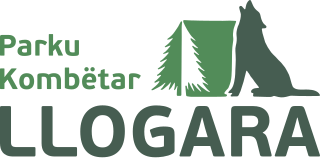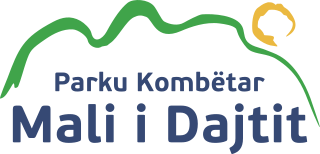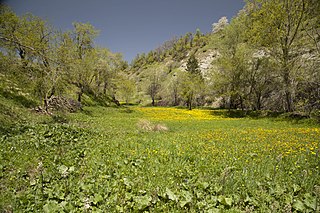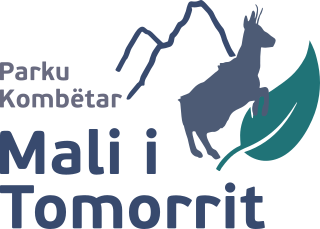
Lurë-Dejë Mountain National Park is a national park in northeastern Albania, spanning an expanded area of 202.42 km2 (78.15 sq mi) since 2018 by encompassing the entire section of Kunora e Lurës, former Zall-Gjocaj National Park, and Dejë Mountain. The park was originally established in 1966 to protect the various ecosystems and biodiversity as Lura National Park. The altitude vary from 1,500–2,300 m (4,921–7,546 ft). The International Union for Conservation of Nature (IUCN) has listed the park as Category II. Nevertheless, it is described as an important Bird and Plant Area, because it supports significant bird and plant species.

Llogara National Park is a national park centered on the Ceraunian Mountains along the Albanian Riviera in Southwestern Albania, spanning a surface area of 1,769 ha (17.69 km2). The park's terrain includes large alpine meadows, vertical rock faces, precipices and dense forests. The most area of land is covered by forests and was established in 1966 to protect several ecosystems and biodiversity of national importance. The International Union for Conservation of Nature (IUCN) has listed the park as Category II. The region has been recognised as an important Bird and Plant Area, because it support significant numbers of various bird and plant species.

Dajti Mountain National Park is a national park established in 1966 in central Albania, spanning an area of 293.84 km2 (113.45 sq mi) since 2006. The park is 40 km (25 mi) east of the Adriatic Sea and 26 km (16 mi) east of Tirana. The area is under shared jurisdiction between Albanian Agency of Protected Areas (AKZM) and Tirana Municipality Parks and Recreation Agency (APR). It is adjacent to Shtamë Pass Nature Park to the northwest, Kraste-Verjon Protected Landscape to the west, and Mali me Gropa-Bizë-Martanesh Protected Landscape to the east. The park is marked by an extremely fragmented, rugged topography which creates favourable conditions for a great diversity of ecosystems and biodiversity.

Shebenik National Park is a national park in eastern Albania adjacent to the border with North Macedonia. It encompasses 34,507.9 hectares (345.079 km2) and is specifically marked by a mountainous landscape supplied with glacial lakes, valleys, dense coniferous and deciduous forests and alpine meadows and pastures. Elevations in the park vary from 300 metres to over 2,200 metres above the Adriatic at the peak of Shebenik and Jabllanica, hence the name. It dwells a number of endangered species that are fast becoming rare in Southern Europe, including the brown bear, gray wolf and balkan lynx. The abundance in wildlife can in part be explained by the variety of vegetation types and remote location.

Theth National Park was a national park in northern Albania. In 2022, the park was amalgamated to form the Alps of Albania National Park. Established in 1966, the park covered 2,630 ha (26.3 km2) and is centred on the Albanian Alps, encompassing the larger portion of Shala Valley. The park was established to protect various ecosystems and biodiversity and the cultural and historical heritage of the region. It is dominated by high terrain, with a wide variety of natural features including valleys, rivers, mountains, waterfalls, dense forests and several rock formations. The International Union for Conservation of Nature (IUCN) has listed the park as Category II. Notably, the region has been also identified as an important Bird and Plant Area. In 2017, Theth has been further declared a Protected Historic Center.

The Valbona Valley National Park was a national park inside the Albanian Alps in northern Albania. In 2022, the park was amalgamated to form the Alps of Albania National Park. The park covers a total area of 80 km2 (31 sq mi), encompassing Valbona River and its surrounding areas with mountainous terrain, alpine landscapes, glacial springs, deep depressions, various rock formations, waterfalls and the Valbona Valley with its dense coniferous and deciduous forest. It is characterized by its very remote areas which have a large preserved ecosystem all of which is primarily untouched with pristine quality. This vast pristine ecosystem is the centrepiece of what has been referred to as the Albanian Miracle of the Alps.

Shtamë Pass Nature Park resides in the edge of the mountain chain north of Tirana, about 25 kilometers east of Kruja. The park is named after the Qafë-Shtamë passage, and has an area of 6,864.36 hectares, with a beautiful mountain scenery consisting mainly of pine forests, some small lakes and major water sources. The national park was established in 1996 by the Albanian government and transformed in 2022 into a larger nature park. It is becoming lately a popular attraction for hiking.

The Fir of Drenovë-Sinicë Protected Landscape is a protected landscape near Korçë in eastern Albania, with an area of 10.3 km2 (4.0 sq mi).

Prespa National Park is a national park situated in southeastern Albania on the border triangle shared with Greece and North Macedonia. At approximately 277.5 km2 (107.1 sq mi), the park encompasses the country's sections of the Great and Small Prespa Lake. It is considerably characterised by high mountains, narrow islands, vast freshwater wetlands, salt marshes, meadows, reed beds and dense forests.

Divjakë-Karavasta National Park is a national park in western Albania, sprawling across the Myzeqe Plain in the direct proximity to the Adriatic Sea. The park spans a territory of 222.3 square kilometres (22,230 ha) containing remarkable features such as wetlands, salt marshes, coastal meadows, floodplains, woodlands, reed beds, forests and estuaries. Because of the park's important and great availability of bird and plant species, it has been identified as an important Bird and Plant Area of international importance.

Tomorr Mountain National Park is a national park founded in 1956 that lies in southern Albania, nestled in the central and higher portions of the Tomorr massif, spanning an area of 261.06 km2 (100.80 sq mi) since 2012, and expanded to include its quarry areas since 2019. The park covers a territory of 26,106 ha. The area falls within the Berat County and only 1,278 ha inside the Elbasan County. The park was established in 1956 and is considered one of the most important protected areas for the maintenance of mountainous biodiversity and ecosystem integrity at the national level. The park has been recognised as an Important Plant Area of international importance by Plantlife.

The Korab-Koritnik Nature Park is a nature park in eastern Albania and forms a section of the European Green Belt, which serves as a retreat for endangered animal and plant species. It encompasses 55,550 hectares (555.5 km2) of alpine mountainous terrain, with valleys, rivers, glacial lakes, caves, canyons, dense coniferous and deciduous forest. The International Union for Conservation of Nature (IUCN) has listed the park as Category IV. Both, Koritnik and Korab has been recognised as an Important Plant Area of international importance by Plantlife.

The Kunë-Vain-Talë-Patok-Fushëkuqe-Ishëm Nature Reserve is a nature park located within the Lezhë County forming the Drin river delta and facing the Adriatic Sea in northern Albania. It spans an area of 43.93 km2 (16.96 sq mi). The area is the first protected area to be established in Albania as a hunting reserve in July 1940. The current nature reserve was established in 2010 encompassing the Kunë Island, the Kunë-Vain lagoon, the woodlands, and several ecosystems. Notably, it has been also identified as an Important Bird Area by BirdLife International.

The Mali me Gropa-Bizë-Martanesh Nature Park is a habitat or species management area in central Albania adjacent with the border with Dajti National Park. It covers a surface area of 25,266.42 hectares (252.6642 km2). It is situated in Dibër and Tirana County with three municipalities, Xibër, Martanesh and Shëngjergj, and several villages within its territory. The International Union for Conservation of Nature (IUCN) has listed the landscape as Category V. The region has been as well recognised as an Important Plant Area of international importance by Plantlife.

The Albanian Ionian Sea Coast is a coastline of the Northeastern Ionian Sea, that encompasses the southwestern border of the Republic of Albania, stretching from the southern half of Karaburun Peninsula, across the historical region of Labëria, the city of Sarandë, the mountains of the Ceraunians and the Albanian Riviera, to the Lake of Butrint, where the Strait of Corfu separates the country from Greece.

The Bay of Grama is a bay in the Ionian Sea situated along the Albanian Ionian Sea Coast on the Mediterranean Sea in Southern Europe. It is one of many bays of the western Ceraunian Mountains along the Albanian Riviera south of the Karaburun Peninsula. The bay is primarily known as a touristic place, and for the engraved inscriptions in the surrounding coastal cliffs as its name relieves.

The National Agency of Protected Areas is a government agency in Albania. Its main duties are focused on the management, protection, development, expansion and operation of the protected areas in the country, which today account for about 21.3% of the territory of Albania. AKZM was established on February 4, 2015, and took many of the functions and duties of former local Forestry Police which was abolished. The newly created local Protected Areas Administrations (AdZM) on a county level are: AdZM Tiranë, AdZM Durrës, AdZM Shkodër, AdZM Kukës, AdZM Dibër, AdZM Lezhë, AdZM Elbasan, AdZM Berat, AdZM Fier, AdZM Korçë, AdZM Vlorë, AdZM Gjirokastër.

Vjosa Wild River National Park is a national park located in southern Albania. The Vjosa River is Europe's first Wild River National Park that was designated on 15 March 2023. The park was declared a natural ecosystem by decision of the Council of Ministers, in compliance with Law 81/2017 "On Protected Areas". The river valley is considered Albania's biodiversity hotspot, offering ideal aquatic habitats for over 1,100 species of wildlife, including otters, the endangered Egyptian vulture and the critically endangered Balkan lynx, of which only 15 are estimated to remain.

Lake Ulza Nature Park is a regional nature park located in Mat, Albania. It covers a surface area of 4206 hectares and is located near the town of Burrel in the central part of the country.



































































